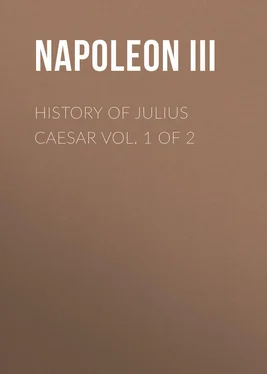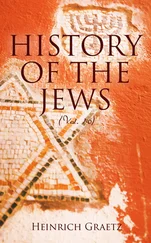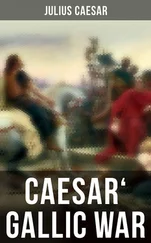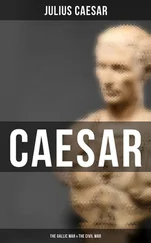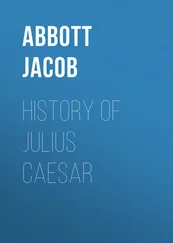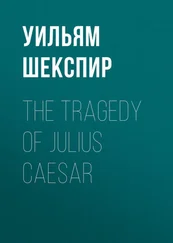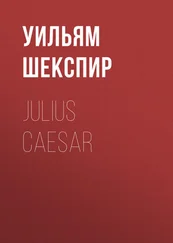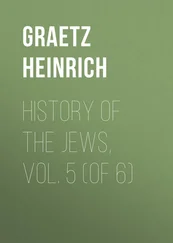Napoleon III - History of Julius Caesar Vol. 1 of 2
Здесь есть возможность читать онлайн «Napoleon III - History of Julius Caesar Vol. 1 of 2» — ознакомительный отрывок электронной книги совершенно бесплатно, а после прочтения отрывка купить полную версию. В некоторых случаях можно слушать аудио, скачать через торрент в формате fb2 и присутствует краткое содержание. Жанр: foreign_antique, foreign_prose, Биографии и Мемуары, на английском языке. Описание произведения, (предисловие) а так же отзывы посетителей доступны на портале библиотеки ЛибКат.
- Название:History of Julius Caesar Vol. 1 of 2
- Автор:
- Жанр:
- Год:неизвестен
- ISBN:нет данных
- Рейтинг книги:5 / 5. Голосов: 1
-
Избранное:Добавить в избранное
- Отзывы:
-
Ваша оценка:
- 100
- 1
- 2
- 3
- 4
- 5
History of Julius Caesar Vol. 1 of 2: краткое содержание, описание и аннотация
Предлагаем к чтению аннотацию, описание, краткое содержание или предисловие (зависит от того, что написал сам автор книги «History of Julius Caesar Vol. 1 of 2»). Если вы не нашли необходимую информацию о книге — напишите в комментариях, мы постараемся отыскать её.
History of Julius Caesar Vol. 1 of 2 — читать онлайн ознакомительный отрывок
Ниже представлен текст книги, разбитый по страницам. Система сохранения места последней прочитанной страницы, позволяет с удобством читать онлайн бесплатно книгу «History of Julius Caesar Vol. 1 of 2», без необходимости каждый раз заново искать на чём Вы остановились. Поставьте закладку, и сможете в любой момент перейти на страницу, на которой закончили чтение.
Интервал:
Закладка:
Elis, protected by its neutrality, was devoted to the arts of peace. There agriculture flourished; its fisheries were productive; it had manufactories of tissues of byssus which rivalled the muslins of Cos, and were sold for their weight in gold. 315The town of Elis possessed the finest gymnasium in Greece; people came to it to prepare themselves (sometimes a year in advance) for competition in the Olympic games. 316
Olympia was the holy city, celebrated for its sanctuary and its consecrated garden, where stood, among a multitude of masterpieces of art, one of the wonders of the world, the statue of Jupiter, the work of Phidias, 317the majesty of which was such, that Paulus Æmilius, when he first saw it, believed he was in the presence of the divinity himself.
Argos, the country of several celebrated artists, possessed temples, fountains, a gymnasium, and a theatre; and its public place had served for a field of battle to the armies of Pyrrhus and Antigonus. It remained, until the subjugation by the Romans, one of the finest cities of Greece. Within its territory were the superb temple of Juno, the ancient sanctuary of the Argives, with the statue of the goddess in gold and silver – the work of Polycletus, and the vale of Nemæa, where one of the four national festivals of Greece was celebrated. 318Argolis also possessed Epidaurus, with its hot springs; its temple of Æsculapius, enriched with the offerings of those who came to be cured of their diseases; 319and its theatre, one of the largest in the country. 320
Corinth, admirably situated upon the narrow isthmus which separates the Ægean Sea from the gulf which has preserved its name, 321with its dye-houses, its celebrated manufactories of carpets and of bronze, bore witness also to the ancient prosperity of the Hellenic race. Its population must have been considerable, since there were reckoned in it 460,000 slaves; 322marble palaces rose on all sides, adorned with statues and valuable vases. Corinth had the reputation of being the most voluptuous of towns. Among its numerous temples, that of Venus had in its service more than a thousand courtezans. 323In the sale of the booty made by Mummius, a painting by Aristides, representing Bacchus, was sold for 600,000 sestertii. 324There was seen in the triumph of Metellus surnamed Macedonicus, a group, the work of Lysippus, representing Alexander the Great, twenty-five horsemen, and nine foot-soldiers slain at the battle of the Granicus; this group, taken at Corinth, came from Dium in Macedonia. 325
Other towns of Greece were no less rich in works of art. 326The Romans carried away from the little town of Eretria, at the time of the Macedonian war, a great number of paintings and precious statues. 327We know, from the traveller Pausanias, how prodigious was the quantity of offerings brought from the most diverse countries into the sanctuary of Delphi. This town, which, by its reputation for sanctity and its solemn games, the Pythian, was the rival of Olympia, gathered in its temple during ages immense treasures; and when it was plundered by the Phocæans, they found in it gold and silver enough to coin ten thousand talents of money (about 58 millions of francs [£2,320,000]). The ancient opulence of the Greeks had, nevertheless, passed into their colonies; and, from the extremity of the Black Sea to Cyrene, numerous establishments arose remarkable for their sumptuousness.
Macedonia.
VIII. Macedonia drew to herself, since the time of Alexander, the riches and resources of Asia. Dominant over a great part of Greece and Thrace, occupying Thessaly, and extending her sovereignty over Epirus, this kingdom concentrated in herself the vital strength of those cities formerly independent, which, two centuries before, were her rivals in power and courage. Under an economical administration, the public revenues rising from the royal domains, 328from the silver mines in Mount Pangeum, and from the taxes, were sufficient for the wants of the country. 329In 527, Antigonus sent to Rhodes considerable succours, which furnish the measure of the resources of Macedonia. 330
Towards the year 563 of Rome, Philip had, by wise measures, raised again the importance of Macedonia. He collected in his arsenals materials for equipping three armies and provisions for ten years. Under Perseus, Macedonia was no less flourishing. That prince gave Cotys, for a service of six months with 1,000 cavalry, the large sum of 200 talents. 331At the battle of Pydna, which completed his ruin, nearly 20,000 men remained on the field, and 11,000 were made prisoners. 332In richness of equipment, the Macedonian troops far surpassed other armies. The Leucaspidan phalanx was dressed in scarlet, and carried gilt armour; the Chalcaspidan phalanx had shields of the finest brass. 333The prodigious splendour of the court of Perseus and that of his favourites reveal still more the degree of opulence at which Macedonia had arrived. All exhibited in their dresses and in their feasts a pomp equal to that of kings. 334Among the booty made by Paulus Æmilius were paintings, statues, rich tapestries, vases of gold, silver, bronze, and ivory, which were so many masterpieces. 335His triumph was unequalled by any other. 336
Valerius of Antium estimates at more than 120 millions of sestertii (about 30 millions of francs [£1,200,000]) the gold and silver exhibited on this occasion. 337Macedonia, as we see, had absorbed the ancient riches of Greece. Thrace, long barbarous, began also to rise out of the condition of inferiority in which it had so long languished. Numerous Greek colonies, founded on the shores of the Pontus Euxinus, introduced there civilisation and prosperity; and among these colonies, Byzantium, though often harassed by the neighbouring barbarians, had already an importance and prosperity which presaged its future destinies. 338Foreigners, resorting to it from all parts, had introduced a degree of licentiousness which became proverbial. 339Its commerce was, above all, nourished by the ships of Athens, which went there to fetch the wheat of Tauris and the fish of the Euxine. 340When Athens, in her decline, became a prey to anarchy, Byzantium, where arts and letters flourished, served as a refuge to her exiles.
Asia Minor.
IX. Asia Minor comprised a great number of provinces, of which several became, after the dismemberment of the empire of Alexander, independent states. Of these, the principal formed into four groups, composing so many kingdoms, namely, Pontus, Bithynia, Cappadocia, and Pergamus. We must except from them some Greek cities on the coast, which kept their autonomy or were placed under the sovereignty of Rhodes. Their extent and limits varied often until the time of the Roman conquest, and several of them passed from one domination to another. All these kingdoms participated in different degrees in the prosperity of Macedonia.
“Asia,” says Cicero, “is so rich and fertile, that the fecundity of its plains, the variety of its products, the extent of its pastures, the multiplicity of the objects of commerce exported from it, give it an incontestible superiority over all other countries of the earth. 341”
The wealth of Asia Minor appears from the amount of impositions paid by it to the different Roman generals. Without speaking of the spoils carried away by Scipio, in his campaign against Antiochus, and by Manlius Volso in 565, Sylla, and afterwards Lucullus and Pompey, each drew from this country about 20,000 talents, 342besides an equal sum distributed by them to their soldiers: which gives the enormous total of nearly seven hundred millions of francs [or twenty-eight millions sterling], received in a period of twenty-five years.
Kingdom of Pontus.
X. The most northern of the four groups named above formed a great part of the kingdom of Pontus. This province, the ancient Cappadocia Pontica, formerly a Persian satrapy, reduced to subjection by Alexander and his successor, recovered itself after the battle of Ipsus (453). Mithridates III. enlarged his territory by adding to it Paphlagonia, and afterwards Sinope and Galatia. Pontus soon extended from Colchis on the north-east to Lesser Armenia on the south-east, and had Bithynia for its boundary on the west. Thus, touching upon the Caucasus, and master of the Pontus Euxinus, this kingdom, composed of divers peoples, presented, under varied climates, a variety of different productions. It received wines and oils from the Ægean Sea, and wheat from the Bosphorus; it exported salt fish in great quantity, 343dolphin oil, 344and, as produce of the interior, the wools of the Gadilonitis, 345the fleeces of Ancyra, the horses of Armenia, Media, and Paphlagonia, 346the iron of the Chalybes, a population of miners to the south of Trapezus, already celebrated in the time of Homer, and mentioned by Xenophon. 347There also were found mines of silver, abandoned in the time of Strabo, 348but which have been re-opened in modern times. Important ports on the Black Sea facilitated the exportation of these products. It was at Sinope that Lucullus found a part of the treasures which he displayed at his triumph, and which gives us a lofty idea of the kingdom of Mithridates. 349An object of admiration at Sinope was the statue of Autolycus, one of the protecting heroes of the town, the work of the statuary Sthenis. 350
Читать дальшеИнтервал:
Закладка:
Похожие книги на «History of Julius Caesar Vol. 1 of 2»
Представляем Вашему вниманию похожие книги на «History of Julius Caesar Vol. 1 of 2» списком для выбора. Мы отобрали схожую по названию и смыслу литературу в надежде предоставить читателям больше вариантов отыскать новые, интересные, ещё непрочитанные произведения.
Обсуждение, отзывы о книге «History of Julius Caesar Vol. 1 of 2» и просто собственные мнения читателей. Оставьте ваши комментарии, напишите, что Вы думаете о произведении, его смысле или главных героях. Укажите что конкретно понравилось, а что нет, и почему Вы так считаете.
